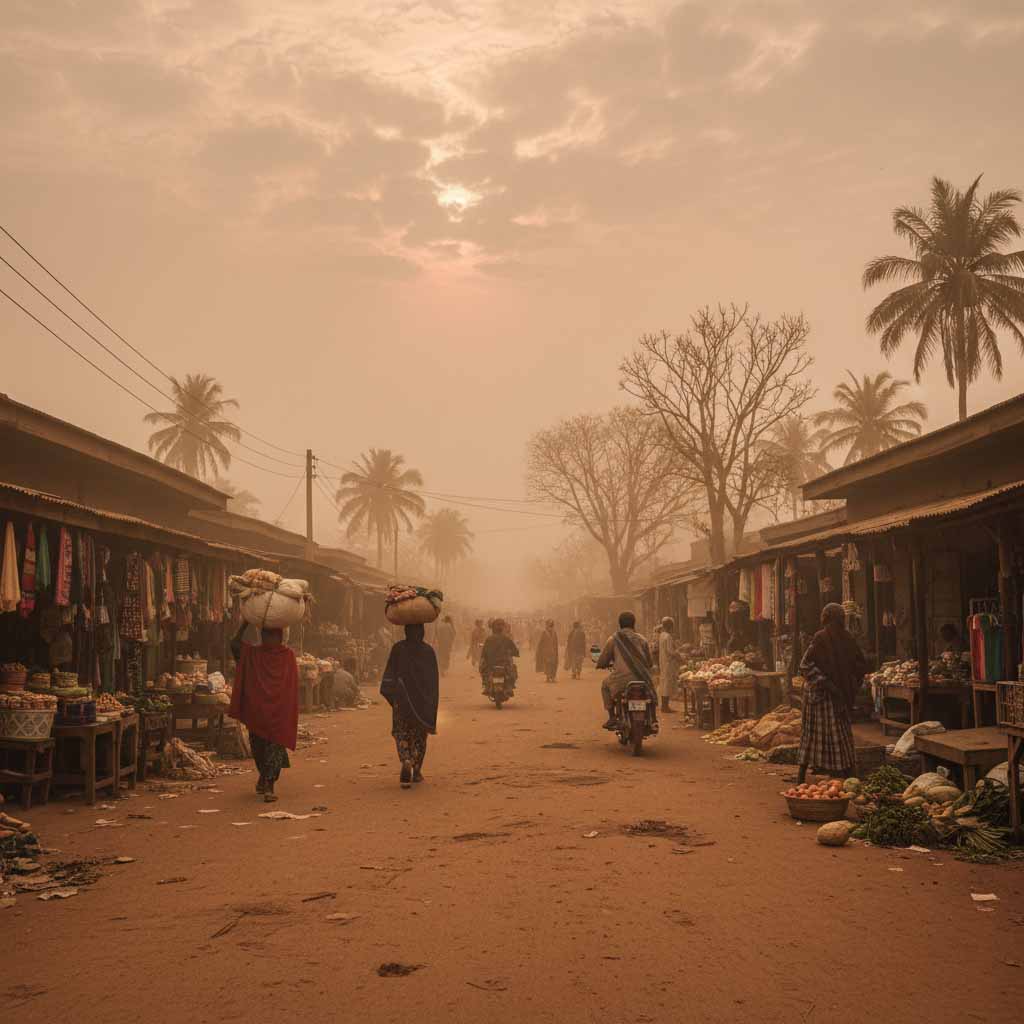The impact of harmattan dust on respiratory health amid climate variability
Published on 12 Nov, 2025

The seasonal haze: Understanding harmattan and its health implications
The Harmattan season, a familiar phenomenon across West Africa, including Nigeria, ushers in a period of dry, dusty north-easterly trade winds originating from the Sahara Desert. Typically occurring between late November and March, these winds carry vast quantities of fine dust particles, significantly altering air quality and visibility. While traditionally associated with cooler temperatures and a respite from humidity, the Harmattan also brings recognized health challenges, primarily affecting the respiratory system, skin, and eyes. As global climate patterns exhibit increasing variability, concerns are mounting that these changes could be intensifying the Harmattan's characteristics and, consequently, its impact on human health, particularly respiratory well-being 1,2.
The nature of harmattan dust: A microscopic menace to the lungs
Harmattan dust is not merely an inert nuisance; it is a complex mixture of fine and coarse particulate matter (PM2.5 and PM10), mineral dust (including silica, clay, and carbonates), and often carries biological materials such as pollen, fungal spores, and bacteria 1,3. The smaller particles, particularly PM2.5, are of greatest concern as they can bypass the body's natural defenses in the upper airways and penetrate deep into the lungs, reaching the alveoli. Once inhaled, these particles can trigger inflammation, oxidative stress, and irritate the respiratory tract, leading to a cascade of adverse health effects 1,3. The physical abrasiveness of the dust can also damage airway linings, making them more susceptible to infections.
Climate variability's influence on harmattan's intensity and reach
The characteristics of the Harmattan season are intrinsically linked to broader climatic conditions. Climate change, with its attendant rising global temperatures, altered rainfall patterns, and increasing land degradation and desertification in arid and semi-arid regions like the Sahel, is thought to influence the Harmattan 2,5. Increased desertification can lead to a greater availability of loose soil and dust particles, potentially increasing the dust load carried by Harmattan winds. Changes in atmospheric circulation patterns, also a potential consequence of climate variability, could affect the intensity, duration, and geographical reach of the Harmattan season. Hotter and drier conditions in source regions can promote more dust uplift, while altered wind strengths could influence how far and how densely this dust is transported 2. While direct attribution studies are ongoing, the plausible links between a changing climate and a potentially more severe or prolonged Harmattan season are a growing concern for public health.
Respiratory health under siege: From irritation to severe illness
The inhalation of Harmattan dust has well-documented adverse effects on respiratory health, ranging from mild irritation to the exacerbation of serious chronic conditions.
Exacerbation of chronic respiratory diseases
Individuals with pre-existing respiratory conditions such as asthma and Chronic Obstructive Pulmonary Disease (COPD) are particularly vulnerable. The irritant and inflammatory properties of the dust can trigger acute exacerbations, leading to increased symptoms like wheezing, coughing, shortness of breath, and chest tightness, often requiring increased medication use or hospitalization 2,3. Studies have specifically linked Saharan dust events to an increased risk of acute exacerbations of COPD 3.
Increased incidence of acute respiratory infections (ARIs)
Harmattan dust can impair local immune defenses in the respiratory tract, making individuals, especially children, more susceptible to viral and bacterial infections. Research in Nigeria has indicated a higher prevalence of ARIs among children during the dry/Harmattan season and in northern regions with greater dust exposure, suggesting a link between dust inhalation and increased infection rates 4.
General respiratory symptoms
Even in healthy individuals, exposure to Harmattan dust commonly causes symptoms such as dry cough, sore throat, nasal congestion, and eye irritation. Prolonged or intense exposure can lead to more significant discomfort and reduced lung function 1. Children and the elderly are often more severely affected due to their developing or more sensitive respiratory systems 2.
Navigating the dust: Strategies for protection and Public health
Mitigating the respiratory health impacts of Harmattan dust requires a combination of individual protective measures and broader public health strategies.
Individual protective actions
- Reduce exposure: Staying indoors as much as possible during peak dust periods, especially for vulnerable individuals.
- Use face masks: Wearing well-fitting face masks when outdoors can help filter out larger dust particles.
- Maintain indoor air quality: Keeping windows and doors closed, and using air purifiers with HEPA filters where feasible.
- Hydration: Drinking plenty of fluids can help keep the respiratory tract moist.
- Manage pre-existing conditions: Individuals with asthma or COPD should adhere strictly to their medication plans and have an action plan for exacerbations.
Public health and policy interventions
- Public awareness and advisories: Issuing timely health advisories during Harmattan season regarding air quality and protective measures 1.
- Strengthening healthcare services: Ensuring healthcare facilities are prepared to manage an increase in respiratory cases during the Harmattan season.
- Air quality monitoring: Investing in and expanding air quality monitoring networks to provide real-time data on particulate matter concentrations 1.
- Addressing root causes: Implementing long-term strategies to combat desertification and promote sustainable land management in dust source regions.
- Climate change mitigation and adaptation: Global and national efforts to mitigate climate change are crucial to potentially lessen the future intensity of dust-generating conditions 2.
Conclusion
The Harmattan season, a defining feature of West Africa's climate, brings with it a significant respiratory health challenge in the form of pervasive dust. As climate variability potentially alters the nature and intensity of this seasonal phenomenon, the impact on lung health, particularly for vulnerable populations in Nigeria and across the region, may be amplified. A comprehensive approach that integrates individual awareness, robust public health preparedness, and concerted efforts to address the underlying drivers of dust generation and climate change is essential to protect respiratory well-being and ensure that communities can breathe easier, even as the environment around them continues to change.
References
1. Atuyambe, L. M., Arku, R. E., Naidoo, N., Kapwata, T., Asante, K. P., Cissé, G., Simane, B., Wright, C. Y., & Berhane, K. (2024). The Health Impacts of Air Pollution in the Context of Changing Climate in Africa: A Narrative Review with Recommendations for Action. Annals of Global Health, 90(1), 76. https://doi.org/10.5334/aogh.4527
2. Bayram, H., Rice, M. B., Abdalati, W., Akpinar Elci, M., Mirsaeidi, M., Annesi-Maesano, I., Pinkerton, K. E., & Balmes, J. R. (2023). Impact of Global Climate Change on Pulmonary Health: Susceptible and Vulnerable Populations. Annals of the American Thoracic Society, 20(8), 1088–1095. https://doi.org/10.1513/AnnalsATS.202212-996CME
3. Mirsaeidi, M., Motahari, H., Taghadosi, M., Esmaeilzadeh, F., & Ghee, A. (2020). Saharan Dust Storms and Acute Exacerbation of Chronic Obstructive Pulmonary Disease. Lung, 198(5), 797–804. https://doi.org/10.1007/s00408-020-00389-5
4. Owoaje, E. T., Oga, A. S., & Owoaje, O. A. (2020). Geographical patterns, drivers and hotspots of acute respiratory infection (ARI) among under-five children in Nigeria. South African Journal of Child Health, 14(4), 198–204. https://doi.org/10.7196/SAJCH.2020.v14i4.1734
5. Rice, M. B., Thurston, G. D., Balmes, J. R., & Pinkerton, K. E. (2023). Climate Change and Respiratory Health: A Call to Action for Clinicians and Researchers. American Journal of Respiratory and Critical Care Medicine, 207(11), 1421–1423.
